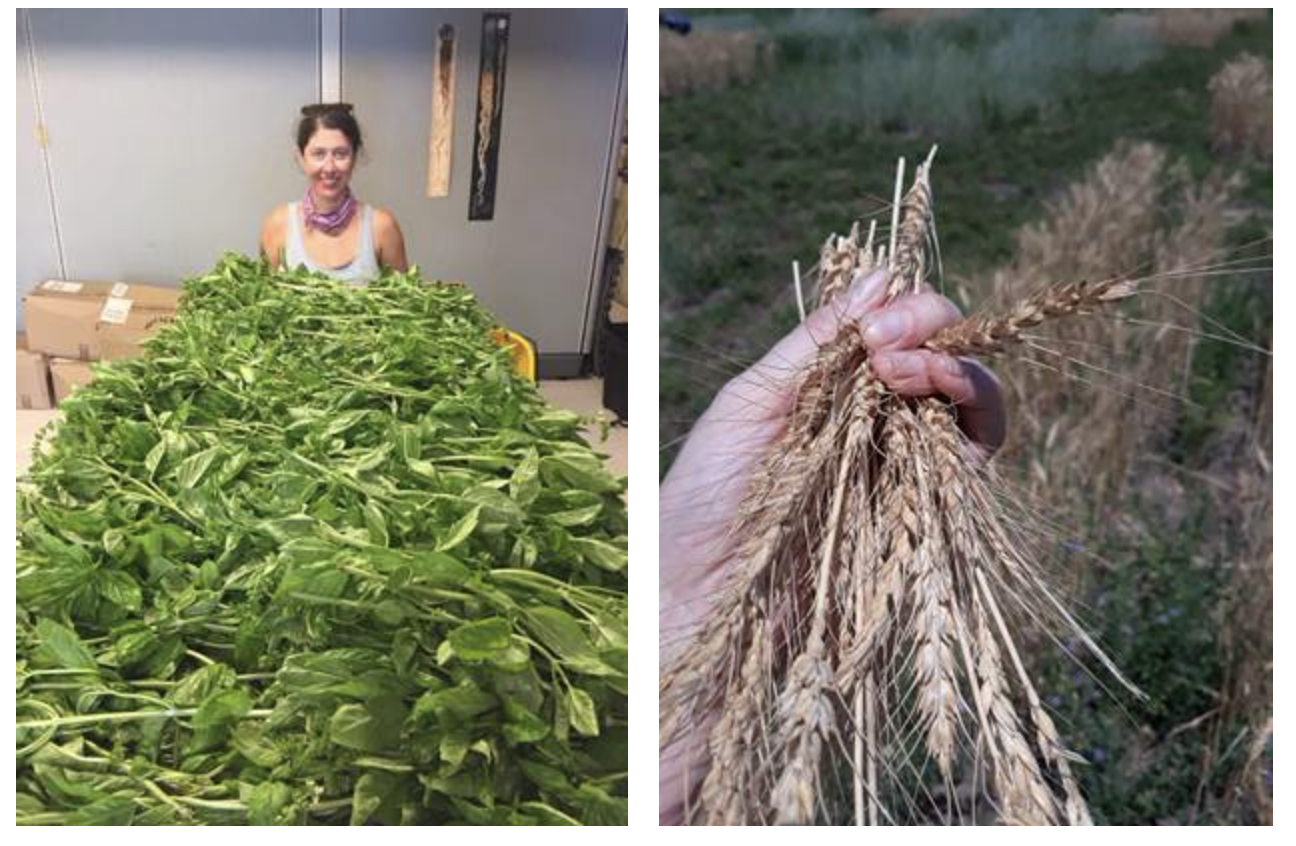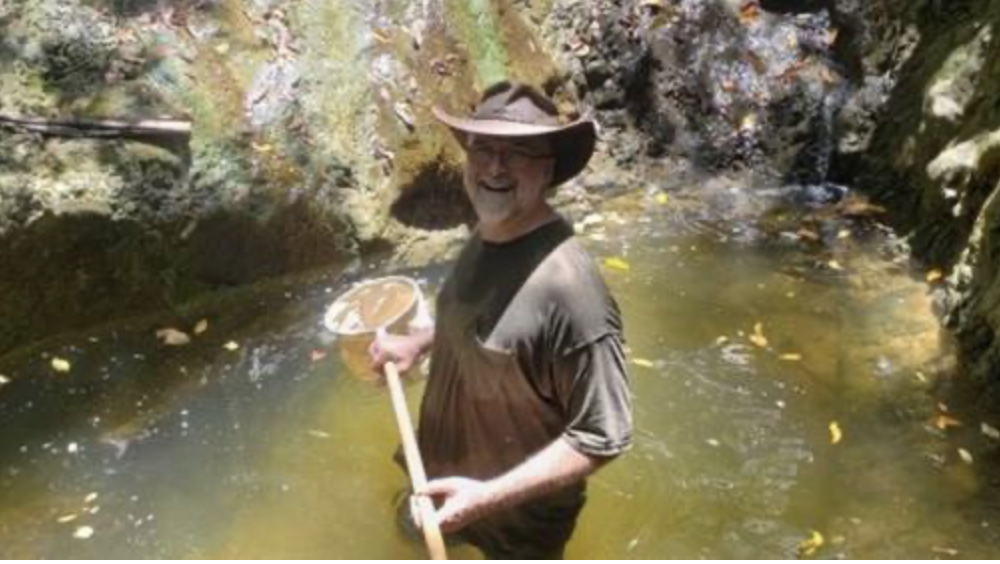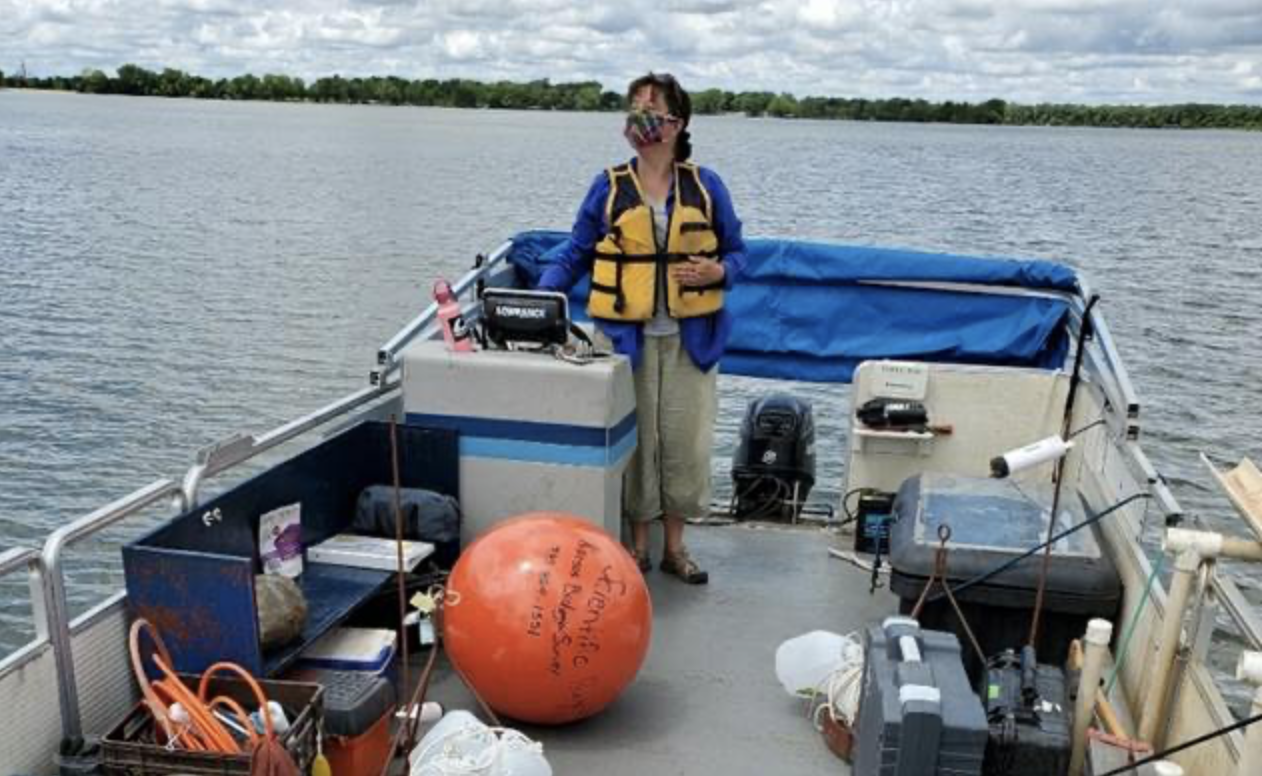Understanding Our Environment

November 2020 Issue
Understanding Our Environment is the internal newsletter for the Kansas Biological Survey & Center for Ecological Research community. Please email biosurvey@ku.edu regarding any errors or omissions.
Photo: Karah Kniola (left) and Becca Kessler, undergraduate assistants in the Harris Lab, presented work the group has been doing at Clinton Lake at the Sept. 18 board meeting of the Association of Kansas Watersheds. (Ted Harris/Kansas Biological Survey)
Comings and Goings
Jerry Whistler, researcher and IT manager, will retire at the end of this year. Jerry started as a GRA in the KARS program in 1983 and became a research associate in 1986. He graduated from KU with a B.A. in geography in 1981 and an M.A. in geography in 1989. He managed the first Kansas statewide land cover mapping project in the late 1980s, and as a core researcher at KARS, he mentored numerous undergraduate and graduate students in GIS and remote sensing. He has been instrumental in developing and maintaining the KARS website and data portal all while keeping our computer labs and systems up and running. Big thank-you and glad you’ll be close by, Jerry. Congrats!
Grants
Amy Burgin and a team of collaborators across eight institutions and five states have been awarded a four-year, $6M National Science Foundation EPSCoR Track 2 grant for the project “Aquatic intermittency effects on microbiomes in streams (AIMS).” Amy is a KU associate professor of ecology and evolutionary biology and an associate scientist with the Kansas Biological Survey. The team includes 18 investigators. Key collaborators are Sam Zipper and Erin Seybold, assistant scientists at the Kansas Geological Survey; Jamene Brooks-Kieffer, associate librarian and data services librarian and coordinator of digital scholarship at KU Libraries; and Jay Johnson, KU professor and chair of geography and atmospheric science and liaison with Haskell Indian Nations University. A full story about the research project was released Sept. 23 in KU Today.
Liz Koziol, postdoctoral researcher in the Bever/Schultz Lab, has been awarded a two-year, $250,000 NSF Partnerships for Innovation grant for her project titled “Manipulating mycorrhizal fungi: Plant symbionts in organic agriculture.” This NSF program supports entrepreneurs. Liz’s previous work has demonstrated that reintroduction of native prairie arbuscular mycorrhizal fungi (AMF) improves the establishment and growth of high-value prairie plant species, such as leadplant, rattlesnake master and pale purple coneflower. Liz has initiated a business that produces and makes native AMF available to prairie restoration practitioners, and agricultural producers also are interested in her product. The award will support her in conducting research that extends her tests of native prairie AMF in restoration and also tests potential benefits in organic agriculture. She will collaborate with Juniper Hill Farms in Douglas County in these tests. The grant co-PI is Jim Bever, Foundation Distinguished Professor of EEB and a Bio Survey senior scientist. 
Ligia Souza, doctoral student in the Billings Laboratory, has been awarded a grant from the Doctoral Student Research Fund in the Office of Graduate Studies for her project titled, “How future nutrient availability depends on the temperature response of soil enzymes.” The funds will cover supplies for the project. Sharon Billings, her advisor, is a senior scientist at the Bio Survey and Dean’s Professor of Ecology and Evolutionary Biology.
Publications
A new paper by Terra Lubin, Helen Alexander and Jim Bever, “Adaptation of plant-mycorrhizal interactions to moisture availability in prairie restoration,” has been published in the journal Restoration Ecology. The paper covers the value of locally adapted mycorrhizal fungi to the success of prairie restorations in Kansas.Terra is a postdoctoral researcher in the Bever/Schultz Lab. Helen is a professor of EEB and a member of the KU Field Station Executive Committee.
Camille Delavaux, doctoral student in EEB and a member of the Bever/Schultz Lab, has published a paper in The ISME Journal, “Root pathogen diversity and composition varies with climate in undisturbed grasslands, but less so in anthropogenically disturbed grasslands.” She also has published a blog post, “How does human disturbance impact plant-associated pathogens, and why does it matter?” on the paper and research context and process behind it in Nature Research Microbiology Community.
Rondy Malik, postdoctoral researcher in the Bever/Schultz Lab, has published a paper in the journal Biogeochemistry that presents a test of local adaptation of tree bark composition: “Bark decomposition in white oak soil outperforms eastern hemlock soil, while bark type leads to consistent changes in soil microbial composition.” Co-authors are Ryan Trexler, David Eissenstate and Terrence Bell, all of Penn State University.
Chip Taylor’s latest paper, “Evaluating the migration mortality hypothesis using monarch tagging data,” has been published in the journal Frontiers in Ecology and Evolution. The research presented concludes that limitation of milkweed (the caterpillars’ summer host plant) could not explain the decline in the overwintering population of monarch butterflies, and the authors hypothesize that increased mortality during fall migration was responsible. Chip is professor emeritus of EEB and director of Monarch Watch, a Bio Survey affiliate program. Co-authors are Ann Ryan and Jim Lovett of Monarch Watch, as well as John Pleasants of Iowa State, and Ralph Grundel and Samuel Pecoraro of the U.S. Geological Survey.
Ted Harris is co-author on a recently published study that took place at the KU Field Station. The article, “Phytoplankton Community Response to Changes in Light: Can Glacial Rock Flour Be Use to Control Cyanobacterial Blooms?” is in the journal Frontiers in Environmental Science, with lead author Jacob Gaskill and co-author Rebecca North, both from the University of Missouri, Columbia. Ted is an assistant research professor at the Bio Survey.
Kelly Kindscher has a new publication, “The Vascular Plants of Lake Roberts, Gila National Forest, Grant County, New Mexico” (attached), in the journal New Mexico Botanist. Kelly is a senior scientist at the Bio Survey and a professor in the Environmental Studies Program.
Christopher Rogers, Bio Survey assistant research professor, has two new publications as well as a forthcoming book:
- in the Journal of Crustacean Biology (attached), “Raman spectroscopic analysis of the composition of the clam-shrimp carapace (Branchiopoda: Laevicaudata, Spinicaudata, Cyclestherida): a dual calcium phosphate-calcium carbonate composition,” with Thomas Hegna of SUNY-Fredonia and Andrew Czaja of the University of Cincinnati;
- in the journal Water (attached; image below), “Pleistocene Branchiopods (Cladocera, Anostraca) from Transbaikalian Siberia Demonstrate Morphological and Ecological Stasis,” with five colleagues at the Russian Academy of Sciences;
- his book, Recent Advances in Freshwater Crustacean Biodiversity and Conservation, with co-editor Tadashi Kawai, chief researcher at the Hokkaido Research Organization, Central Fisheries Research Institution, Japan.
Jacob Hopkins, Tanya Semenova-Nelsen and Ben Sikes have just had a paper, “Fungal community structure and seasonal trajectories respond similarly to fire across pyrophilic systems,” accepted by the journal FEMS Microbiology Ecology. The work shows that, in both tallgrass prairie and pine savanna, fires alter the seasonal trajectories of soil fungal communities. The prairie work was conducted at the KU Field Station, including the Dogleg and Rockefeller prairies. Ben is an associate scientist at the Bio Survey and an associate professor of microbial ecology. Jacob is a doctoral student in the Sikes Microbial Lab. Tanya formerly was a postdoctoral researcher in the Sikes Lab and is now a scientist at WuXi AppTex in Philadelphia.
Jude Kastens, Bio Survey associate research professor, developed maps showing the massive areas of Oregon and northern California burned during wildfires, as detectable in the latest satellite NDVI (Normalized Difference Vegetative Index) “greenness” imagery. One map was published by Bio Survey partner Planalytics in a weekly GreenReport newsletter.
Awards
Many years ago Christopher Rogers was part of a team that worked on the Whetstone Savanna Restoration Project in Oregon for the Oregon State Department of Transportation. He was one of many restoration biologists involved and worked on the needs of the federally endangered fairy shrimp species. In addition to conducting surveys and monitoring species, as well as design, restoration and monitoring of their seasonal wetland habitat, he trained U.S. Fish and Wildlife Service staff, ODOT staff and consulting biologists. The Whetstone Savanna was recognized by the Oregon State Land Board with this year’s Wetland Project Award. The project is the largest vernal pool grassland in the state and took more than a decade to reach its current status.
Ashley Wojciechowski, graduate teaching assistant in the Baer Ecology Lab at the Bio Survey, learned in September that she received third place in the Ecological Restoration Student Poster Competition at the ESA (Ecological Society of America) conference in August. Her poster title is: “Environmental heterogeneity increases resilience of stored grassland to interannual variability in precipitation.”
Publicity
The St. Thomas Source, the local paper in St. Thomas, U.S. Virgin Islands, treated its readers to a fun and informative story—“To better understand water quality, researchers look to the spineless”—on the discovery of a new species of clam shrimp at the university golf course there by Edwin Cruz-Rivera of the University of the Virgin Islands and Christopher Rogers, Bio Survey assistant research professor.

The Hillsboro Free Press, which covers Marion County, Kansas, published a story on a joint project of KU and Wichita State University researchers at Marion Reservoir: “WSU and KU researchers join forces to fight blue-green algae.” The project is led by Ted Harris, Bio Survey assistant research professor, and funded by a grant from the Kansas Dept. of Health and Environment. Don Huggins, Bio Survey senior scientist, and Bio Survey researcher Debbie Baker are also part of the research team.

The Kansas State Collegian covered the Monarch Watch program, a Bio Survey affiliate program, in its October article “’One tough little butterfly’: Monarch Watch uses citizen science to track butterflies from Canada to Mexico.”
Outreach
Ben Sikes recently did a virtual outreach event for the Independence (Kansas) Public Library for KU Natural History Museum’s Microbes on the Move. He led a walk in the woods and talked about fungi then brought samples back and looked at them through a microscope at his home.
Online
The Kansas Biological Survey now has a YouTube channel where we have been posting videos of our Friday Ecology Seminars, research activities and more. If you or people you know are interested, please subscribe. Once we reach 100 subscribers, we can customize our address so that it looks like us. We will link the channel to our website soon.